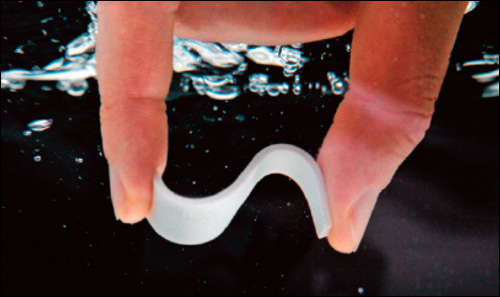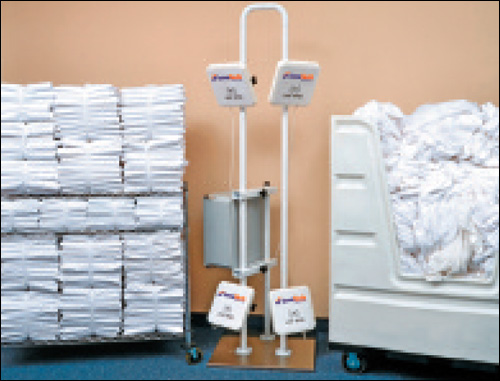Aug 30, 2016Reducing Food Waste in Groceries
Retailers can use Avery Dennison's tags to track totes in the supply chain and perishable items in stores.
Food retailers face many challenges when it comes to keeping their shelves well stocked with a wide variety of fresh perishable items, including dairy, meat and produce. Managing inventory and rotating stock—including tracking sell-by dates—are labor-intensive processes. Expired foods must be discarded, which impacts a store's bottom line.
Most food retailers use bar codes to manage inventory, says James Stafford, global head of food RFID development at Avery Dennison Retail Branding and Information Solutions (RBIS). But manual processes are inefficient, he says, and packages that need to be moved can be inadvertently overlooked when a store is busy or during shift changes.
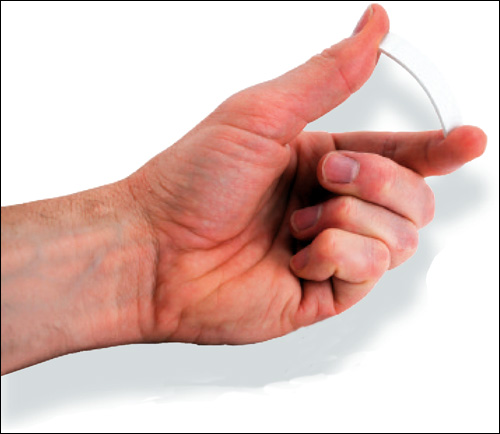
To automate tracking perishables in the supply chain and within stores, Avery Dennison RBIS developed three passive ultrahigh-frequency EPC RFID tags specifically for the food industry. The company is working with several major food retailers in the United States and Europe on pilot programs to confirm the benefits of RFID's use on fresh foods at both the distribution and item levels, Stafford says.
In the supply chain, Stafford says, "We needed an RFID tag that could be used on disposable delivery cartons and also a waterproof encapsulated version that could withstand multiple washing cycles over many years when placed on returnable totes." Both versions are based on the AD-237 inlay incorporated into a label.
"Totes are a very efficient way of managing the inventory of cheaper fresh foods with a short shelf life, such as dairy products or produce," Stafford says. Attaching a permanent RFID tag allows totes to be tracked accurately and quickly throughout the supply chain, he says, and helps ensure 100 percent delivery accuracy to the final destination. Because the same tag is used on multiple journeys, he adds, this is a cost-effective way of deploying the technology.

The AD-229 tag is designed for item-level tracking. The label is accurate at low temperatures and in the presence of foods with high water content, such as meat and poultry, Stafford says. "For higher-value perishable products, such as meat, each individual package can benefit from its own RFID tag," he explains, "so we needed to design tags that could be attached to the existing food packaging by the manufacturer and would work well in a refrigerated environment.
"A further consideration is that a customer may accidentally forget to remove the food packaging and place it in a microwave," Stafford says. "We are refining our AD-229 design to ensure it is safe in these circumstances."
A secondary benefit of item tagging is that the same RFID tags can be used for loss prevention of individual items. RFID scanners at store exit points can detect tags that have not been read at point of sale and create alerts for store staff, Stafford says. This saves the labor cost of applying conventional electronic article surveillance tags in store, he adds.
The unique information within an RFID tag, which is far more detailed than the data contained in a bar code, will create new opportunities to improve inventory productivity, margins, store-operations execution and overall customer experience, Stafford says. The pilot programs have already yielded key benefits for the retailers involved, Stafford says, though he declines to identify any of the customers or discuss specifics of how the retailers are using the tags. The benefits include enhanced supply-chain visibility of stock, increased speed and accuracy of receiving, reductions in food waste through increased visibility of expiration dates and increased item-level availability.
Food retailers can create rapid reports of both product availability and residual life throughout the supply chain, Stafford says. "First, the information helps them improve their stock rotation techniques and offers early visibility of overstock situations," he says. "This visibility enables them to take price action to clear excessive stocks and help minimize waste.
"Retailers deploying the technology should be able to reassure regulatory authorities that all reasonable precautions are being taken to avoid the sale items that are past their use-by or sell-by dates," Stafford says.
"We're helping to reduce the labor cost to inspect foods," he notes. "You can get up to 100 percent accuracy reads in food distribution. We're reducing food stock management costs by about 50 percent and food waste by around 20 percent.
"The old compromise between speed and accuracy disappears," Stafford says. "Now retailers can get real-time information on inventory at a speed that was impossible in the past. We believe this will create a paradigm shift in the management of fast-moving consumer goods such as foods."
Making In-Store Shopping Fun Again
Keonn's interactive AdvanLook solution engages customers and provides the information they need to make a purchase.
As more consumers turn to online shopping, brick-and-mortar retailers have been trying to differentiate their stores from the competition and lure people back inside. One way is to use item-level RFID to improve inventory accuracy and ensure products are on the shelves when customers want to buy them. Another way is to make shopping easier and more fun, and Keonn Technologies' interactive AdvanLook solution is designed to do just that. "Typical stores sell products to customers," says Ramir De Porrata-Doria, Keonn's co-founder and CEO. "With AdvanLook, stores also sell an experience."
Holavisió, an eyewear store in Barcelona, is one of 10 retailers in the United States and Europe that has adopted the AdvanLook solution since it was introduced in 2014, De Porrata-Doria says. The solution includes an encoding station, which Holavisió uses to identify each pair of sunglasses with a passive ultrahigh-frequency EPC Gen 2 RFID tag.
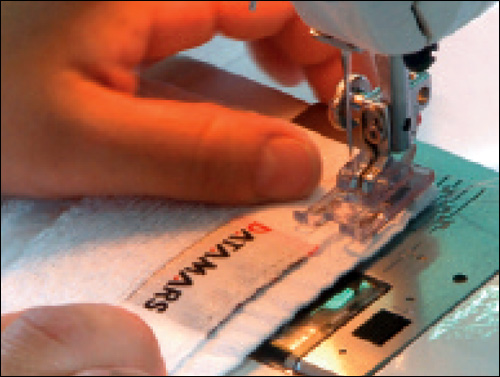
When a customer is interested in a particular pair of sunglasses, he or she can take them over to a 42-inch AdvanLook touch screen. The wall-mounted screen has a has an integrated RFID reader and antennas to identify the tagged frames. A local AdvanCloud software agent sends the content request to the system's cloud-based software platform. Within fractions of a second, the screen displays information about the lens and frame technology, as well as available colors and sizes.
The software agent also manages touch-screen requests. For instance, once the product information appears, a store associate uses the touch screen "to show the customer the different colors available for that specific model and the different frame and lens technologies," says Ricard Puig, Holavisió's general manager. "In eyewear retailing, each glasses manufacturer has very specific technologies for each type of lens and frame," he explains, noting that it's nearly impossible for store associates to remember such a myriad of details, so in the past they'd inadvertently give customers incorrect or imprecise information. "With AdvanLook we have all this information inside the system, immediately available, and it makes everything much easier."
Now, Puig says, store associates can quickly explain to customers all the specifics about the technologies used in the glasses they're interested in. "Furthermore," he says, "we can show the customer the availability of different colors and sizes of the chosen model in an instant, without having to look through a catalog." If customers aren't ready to make a decision, he adds, the store associate can e-mail the information to them.
Holavisió also uses AdvanPay, an RFID reader, at the point of sale to speed payments. AdvanPay can detach hard tags and transmit data to the AdvanCloud software platform.
Since deploying the system in June 2016, Holavisió has seen sales increase by 25 percent, Puig says. "Customers remember our store because of AdvanLook," he says. "It is our main differentiator."
The implementation took only a matter of days, Puig says, because the retailer's website contained all the information and content, including product images and descriptions, that had to be fed into AdvanLook. "The only challenge was to work in the composition of a spreadsheet," he adds, to upload the data to the AdvanCloud platform.
In September, Holavisió is scheduled to begin using AdvanScan, a handheld reader for managing product inventories, in one store. The retailer intends to deploy AdvanLook in all its stores, Puig says.
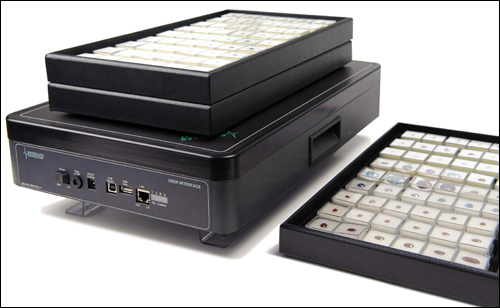
In addition to eyewear, AdvanLook supports a variety of retail products, including apparel, cosmetics, footwear, jewelry and sporting goods, De Porrata-Doria says. Spanish footwear company Munich Sports, for example, has been using the solution at a children's store in La Roca Village, near Barcelona. The technology has been popular with customers, says Xavier Berneda, Munich Sports' general manager. The system has increased the speed of the shopping process, he reports, while also making workers more productive and boosting the store's image for innovation.
The solution's wall-mounted touch screen comes in a variety of sizes, from 10 inches to 46 inches, and the interactive AdvanLook display is available as a horizontal tray or a fitting-room mirror. The user interface, based on HTML5 templates, can be customized to a retailer's needs, De Porrata-Doria says. Apparel retailers, for example, can use AdvanLook to recommend complementary items that create a particular look.
AdvanLook can perform other functions, including displaying user ratings and reviews, enabling customers to share items on social media and emailing potential customers with information about selected products. If a desired item isn't available in a store, a touch screen can display a map with nearby stores that have the item in stock. Retailers can also use AdvanLook to let customers pay for products through PayPal on their smartphones, to avoid checkout lines.
AdvanLook reads all kinds of UHF Gen 2 RFID tags, including wet inlays, paper labels and hard tags, De Porrata-Doria says. Depending on the tag's sensitivity, the reader's power and sensitivity might have to be adjusted, he adds.
Data generated by an AdvanLook touch screen can be compared with data from the point of sale, so retailers can analyze customer behavior. They can know, for example, which products customers examined and which they bought. Retailers can also learn which product colors are most popular, the time of day and days of the week when purchases of specific products are made, and which items are shared on social media.
"Some retailers prefer to start using RFID for inventory or for loss prevention, and later they adopt AdvanLook for enhancing the customer shopping experience and increasing sales," De Porrata-Doria says. "But some retailers that put a lot of importance in the customer experience start using RFID with AdvanLook [and] later they adopt RFID for inventory and other purposes. The decision depends on what is the main priority for the retailer: inventory accuracy or customer experience."
Preventing Eavesdropping and Tag Cloning
NXP's Ucode DNA chip provides cryptographic authentication of vehicles at long read ranges.
There are many good reasons to identify vehicles with RFID tags: The tags can be used to authenticate license plates, enable electronic toll collection, automate parking access, enforce traffic laws and search for stolen vehicles.
There's also one good reason not to: security concerns.
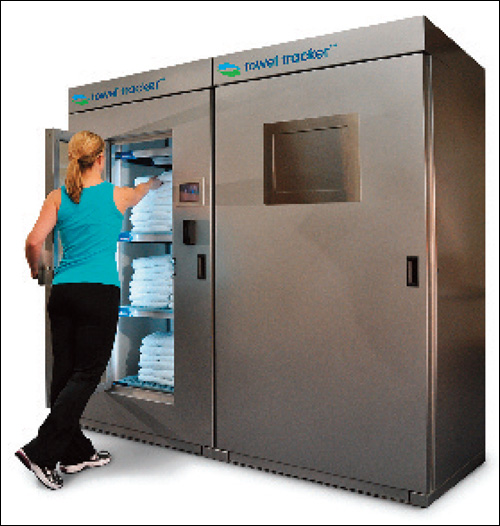
Typically, applications that require security, such as verifying banking cards, passports or transportation tickets, use passive high-frequency RFID tags, which have a short read distance, making it unlikely that someone could eavesdrop on or clone a tag. But the ability to identify HF tags only when they're placed directly in front of a reader made them impractical for vehicle identification.
Last year, global semiconductor company NXP Semiconductors introduced the Ucode DNA integrated circuit, a passive EPC Gen 2 ultrahigh-frequency RFID chip designed to prevent both eavesdropping and tag cloning. It provides cryptographic authentication at long read ranges (10 meters/30 feet or more), says Mahdi Mekic, NXP's marketing director for smart mobility solutions. The chip, which can be read via most standard UHF readers, transmits an encrypted message that changes with each read event and requires decryption of each message by utilizing a cryptographic key that is securely stored either in the reader device or on a back-end server. This prevents a tag from being read without authorization.
A tag that combines long-range contactless performance with cryptographic security for tag authentication was just what the Tönnjes Group, a global supplier of security license plates and vehicle registration and identification systems, required, says a spokesperson for the German company, which began using Ucode DNA in May 2015. "In order to prevent theft and misuse of license plates, we have to enable a reliable and tamperproof identification process," the company rep says.
Tönnjes uses the Ucode DNA chip in its license plate (IDePLATE ) and windshield label (IDeSTIX) vehicle identification systems. The chips are integrated into both during the production process, and contain a unique and unchangeable identification number. "Using the Ucode DNA, this number can be transmitted encrypted," the spokesperson says. "Authorized reading devices enable a reliable identification and secure verification."
The license plate technology becomes increasingly important as the number of applications using the plates rises, the spokesperson says. In addition to the original function of identifying cars for registration purposes, the license plates can now be used for a variety of applications, including traffic management, parking and access control.
The Ucode DNA chip "opens up new opportunities regarding applications based on our products," the spokesperson says. "We no longer have to choose between contactless performance and the need for secure verification. Additionally, it enables a privacy protection in full compliance with European Union regulations on data privacy."
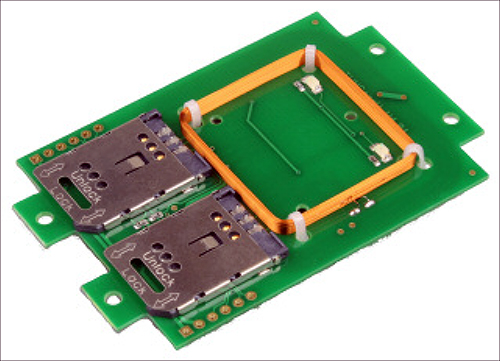
"Many companies talk about secure RAIN UHF solutions and what they mean is a variety of low- to medium-level protection mechanisms such as passwords, proprietary protocols and encrypted user memory," Mekic says. What all these protection schemes have in common, he explains, is that they're based on static memory content that gets sent over RF waves between tag and reader.
"As such, these systems are susceptible to cloning and emulating," Mekic says. "With cryptographic authentication, which is the key capability of Ucode DNA, security is based on a high-level cryptographic scheme that uses crypto keys." These keys never get transmitted over the RF waves—they're used only within the chip for cryptographic calculations.
Government and business customers in North America, Europe, Southeast Asia, Africa and South America are using the chip for automatic vehicle identification and other applications, Mekic says. The chip can be integrated into cards or wearables to provide the convenience of hands-free access control while maintaining a high level of security, which is important in restricted areas of hospitals or factories. People with disabilities can use an RFID card to access public transportation. The Ucode DNA chip is also being used for secure asset tracking in the automotive, health care, and oil and gas industries.

